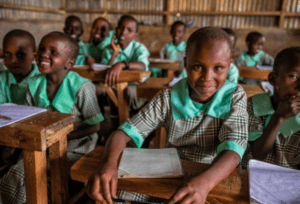It seems obvious that nutrition dictates the quality of children’s general wellbeing. Naturally, children who are left hungry because of personal circumstances are vulnerable to disease and malnutrition. Yet inevitably, they are also likely to be unable to concentrate well at school, and that is even if they are able to attend school in the first place. For across the globe many children instead undertake chores and caregiving roles for their family and siblings.
Surely the future economic prosperity of a country lies in its children’s hands? Yet what chance do children who are underfed have to make a genuine impact for good on their own society?
On the other hand, children who benefit from a decent, nutritious diet and have access to basic healthcare facilities, have every chance of thriving in later life. One immediate impact can be seen in education. For when at school well nourished children concentrate better in class. It is more likely that they will ultimately be productive and energetic members of their society. And they will help their communities to move beyond poverty.
 It should come as no surprise that nutrition is enshrined in international covenants, for example, the United Nations’ Convention on the Rights of the Child. It is also fundamental to the same organisation’s seventeen Sustainable Development Goals.
It should come as no surprise that nutrition is enshrined in international covenants, for example, the United Nations’ Convention on the Rights of the Child. It is also fundamental to the same organisation’s seventeen Sustainable Development Goals.
In Kenya, two hundred and sixty children from every thousand under the age of five are classed as ‘stunted’. This upsetting classification essentially means that those children are too short and look underdeveloped among their peer group. In turn, they will be physically and cognitively at a disadvantage to those around them as well as those of their age across the globe.
Economically speaking, poverty and poor diet continue to undermine poor children’s chances of a productive future.
The United Nations’ 2020 short rains assessment confirms that a number of Kenyan counties such as Mandera, Marsabit and Turkana have critical levels of acute malnutrition.
The global pandemic also hurt the poorest communities most, and children always seem to bear the brunt of such problems. While daily curfews and restrictions helped to counter the spread of the virus, they also exacerbated the conditions of abject poverty for countless already very poor people. For many families, basic food became a luxury, and many went hungry for extended periods. Schools were closed and with them went the chance for the most vulnerable pupils to enjoy a free, or subsidised, school meal. Healthcare facilities were restricted or suspended and many children faced a very bleak time.
 Moreover, the impact of climate change in Kenya means long dry seasons and unreliable rainy seasons. This has led to greater food shortages as ninety eight percent of cereal and vegetable crops are rain dependent. Farmers have struggled to maintain their supplies and many herdsmen have lost their animals due to years of drought conditions.
Moreover, the impact of climate change in Kenya means long dry seasons and unreliable rainy seasons. This has led to greater food shortages as ninety eight percent of cereal and vegetable crops are rain dependent. Farmers have struggled to maintain their supplies and many herdsmen have lost their animals due to years of drought conditions.
UNICEF estimates that a sizeable majority of children go to school without the chance to have breakfast. There are 10.3 million children enrolled at primary school and a further 3.7 million at secondary school. Many of these walk long distances to attend their classes. They cannot possibly concentrate when they sit in lessons feeling hungry on a daily basis.
Yet there is an incontrovertible argument for investment in feeding children in countries like Kenya. A World Bank report exploring child malnutrition finds that for every thousand Kenyan shillings invested in childhood nutrition, over twenty two thousand shillings will be generated for the economy. What an extraordinary investment return that is.
Thankfully there is a political willingness to tackle child malnutrition in Kenya. The government’s Nutrition Action Plan (2018-22) promotes improved diet for mothers and children across the country. Moreover, UNICEF and the World Bank are collaborating with the government and several counties to address nutritional issues. The programme intends to reach over twenty three thousand vulnerable families over a five year period. Working with communities to implement programmes to tackle poor nutrition should lead to long term, sustainable solutions. 
Yet while the United Nations’ and World Bank work to address this issue, there are those unsung NGOs which already tackle child poverty and hunger as part and parcel of their missions. For instance, one UK based charity, The Langalanga Trust, presently delivers seventy two thousand school meals a year to pupils attending two primary schools in an impoverished district in rural Kenya. For many of the pupils at Ndogo and Mwega primary schools, this is life enhancing. It means that those children are receiving a reliable and nutritional daily meal in the form of a mug of uji, or Kenyan porridge, made from maize meal and beans. It is served free of charge. The scheme is project managed by one of the Trust’s scholarship alumni, Daniel Githinji. The evidence speaks volumes, the children are better motivated to attend school regularly and they pay closer attention in lessons.
Nationally speaking, ministers levy nominal fees towards school meals, and have invested in and trialled smart wrist bands for pupils to record meals taken. However, costs for these meals may backfire onto the poorest children. Will their families consistently be able to pay even the nominal charge of a few shillings? Will they buy into the notion that they are helping to support their children when in many instances they have no money?
President Ruto’s government is aiming to reach four million children with the government’s new campaign, an ambitious sounding roll out. Their problem remains finding the poorest four million children, and beyond them, those millions more who do not attend school because of their families’ abject poverty and everyday needs. Much remains to be done to ensure that Kenyan children of all backgrounds can enjoy and genuinely benefit from the basic human right of education. A simple, nutritious mug of uji is a promising start.

